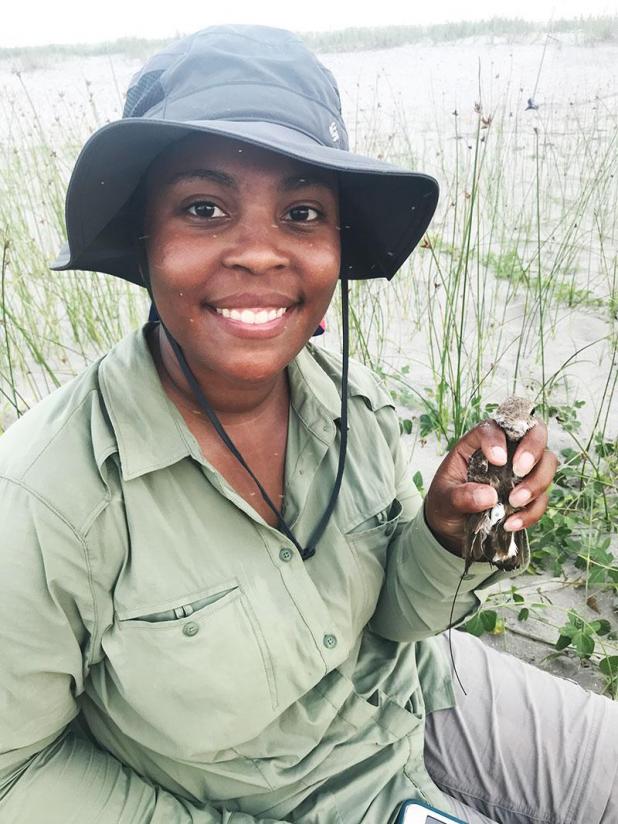
Kiah Williams with a banded Wilson’s Plover.
(Submitted Photo/Kiah Williams)
New Orleanian's study hopes to learn more about shorebirds
As a young girl, Kiah Williams always enjoyed science in school. She also loved animals and has had pets pretty much her entire life.
Growing up in New Orleans, the 29-year-old Tulane PhD student says her mother sort of fostered her curiosity about animals. As a child, she’d often catch bugs and green anoles outside in the yard. Williams claims she was the unofficial gecko catcher in the family, as her mom was afraid of the small creatures.
She also says her mother and grandmother would often take her to her favorite places to go in the city: the Audubon Zoo and the Aquarium of the Americas on the river front.
After high school, Williams studied Natural Resource Ecology and Management at the LSU School of Renewable Resources. She found ornithology really interesting, where after graduating put her skills to work over the next several years doing field work, ultimately landing a coastal bird technician job with Audubon Louisiana.
In 2017 while hiking and birding in Jean Lafitte National Historic Park and Preserve, Williams ran into Caz Taylor, a Tulane associate professor and population ecologist. After discussing their respective interests, Taylor encouraged Williams to apply for her PhD at Tulane.
In April, my wife and I were spending time on Elmer’s Island near Grand Isle looking for wading and shorebirds to photograph. While walking the beach, Christine came across a Wilson’s Plover that appeared to be dragging a piece of fishing line or something.
Calling me over to see the bird, I was too late. The bird scampered off and disappeared into the scrubby beach cover. But, looking at her camera’s display, we could see the bird had a band with numbers we couldn’t make out on one leg and a yellow marker band on the other leg with the letters “OT” on it. And, what appeared to be fishing line was actually a frayed nanotag Motus Wildlife Tracking device antenna.
There was enough information for Christine to be able to report the bird to the U.S. Geological Service Bird Banding Laboratory as an encounter. Upon receiving her certificate of appreciation, we learned that the bird was banded under Audubon Louisiana Director of Bird Conservation Erik Johnson’s permit by a PhD student named Kiah Williams.
As it turned out, my wife’s OT bird was one of 10 Wilson’s Plovers tagged in 2018 by Williams during her first year of field work on Grand Isle. What’s more, a bird that scientists know little about.
Williams, now in her second year of field work said, “Wilson’s Plover is just a generally understudied beach nesting bird that nests on the coast of the southeastern United States, particularly much of southeast and southwest Louisiana’s coastline. They’re very secretive. They’re solitary nesters. So I guess that’s what got me interested in them and thinking about what I wanted my project to be in school.”
Titles to Williams’ studies include “Parental Investment and Chick Survival in Wilson’s Plovers” and “A Study of Wilson’s Plover Natal Dispersal in Southeast Louisiana”, both of which are extremely important in learning more about the species.
“My goal was to successfully tag breeding birds and fledglings at the end of the season around July or August,” Williams said, “because I was curious if they left at different times or if males and females had different behaviors. Hopefully, I’d also get the days that they returned when they came back to the breeding site.”
According to Williams, seven out of 10 of the Wilson’s Plovers that she tagged during her first year in the field returned to the same region. My wife’s OT bird was one of them.
A female that hatched in 2017, it’s possible that OT migrated all the way to Central America and back. Audubon Louisiana research has documented two Wilson’s Plovers that relocated to the Pacific coast side of Costa Rica during migration.
William’s second project is trying to learn more about the period of time from hatching to fledging. Because the birds are so well camouflaged after hatching, biologists often times have no way of knowing where the chicks are.
“I thought maybe if we can find tags that are small enough, then we can tag chicks and track them across the beach and see what their movements are, where they’re traveling, and what sorts of behaviors they have with the adults they are associated with,” Williams said.
Much of Williams’ work takes place on Grand Isle during the hottest months of the year, June through August. There are also gnats, deer flies and mosquitos to contend with.
“I’m from New Orleans, so I guess in that respect I was kind of prepared for the conditions. Usually in Grand Isle it’s a bit cooler than it is in New Orleans, so that’s nice. And, I sort of remind myself of that any time I think, ‘Man it’s really hot outside.’ It’s hard work, but at the end of the day, it’s an accomplishment — you know — learning information that we can add to the knowledge of this bird that no one really knows much about,” Williams said.
Going forward, Williams said she would like to do research, whether that is with an agency, nonprofit or university that may also require teaching.
“I just sort of do what I like and just let things happen the way they are supposed to happen,” Williams said. “I do like to plan, but it’s a loose plan. I’m open to anything.”
EDITOR’S NOTE: Flores is The Daily Review’s outdoor writer.
